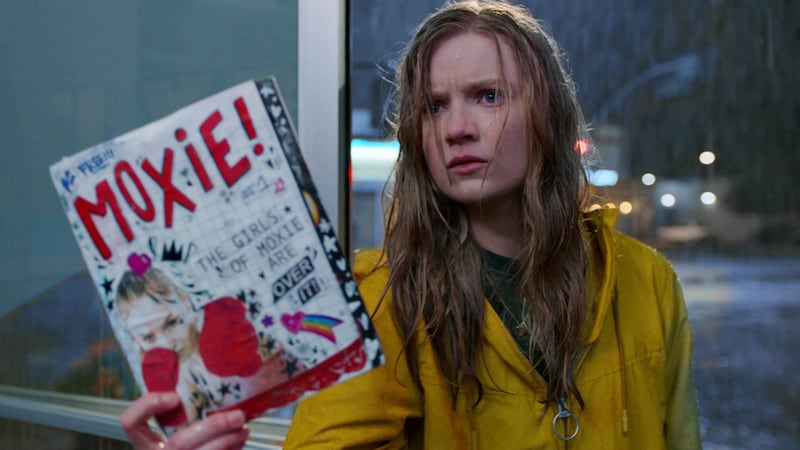The latest film directed by multihyphenate Amy Poehler is Moxie, a coming-of-(r)age teen dramedy adapted from Jennifer Mathieu's eponymous novel about the positive power of punk. Hadley Robinson plays Vivian, a shy teen who's sick and tired of the ingrained misogyny she and the other girls at her high school are forced to endure daily—everything from boys creating objectifying and cruel lists about their female classmates' looks to the snide principal (Marcia Gay Harden) enforcing archaic dress codes. After Vivian discovers her mother (Poehler) was a third-wave feminist in the '90s, she taps her knowledge about riot grrrl music and culture. That inspires the creation of a rebellious zine called MOXIE!, which Vivian distributes in the girls' bathrooms at school. With the support of her friends (Alycia Pascual-Peña and Lauren Tsai), Vivian channels their collective anger and frustration into effecting positive and radical change on campus.
And since you can't make a riot grrrl movie without paying homage to the Pacific Northwest—this specific feminist punk movement began in early '90s Olympia, Wash.—the story is set around Portland. Little bits of Oregon are "sprinkled throughout the film," according to Robinson, who said the production shot for about two weeks on location in our state. Eagle-eyed Oregonians will spot the Umpqua Dairy stickers on Vivian's laptop, University of Oregon memorabilia in the classrooms, and the implausibility of the students' attending an outdoor high school (with our perpetually drenched climate? As if!).
Nevertheless, Moxie begins with a forested nightmare sequence that very clearly was filmed here. Vivian runs through the woods, desperately opening her mouth to scream, but nothing comes out. It's a helpless, hopeless feeling that many young women can relate to. It's also incredibly redolent of the opening scene from another Pacific Northwestern staple, 2008's Twilight, but Robinson said this tribute was unintentional, even though she admitted she had the same thought while filming.
What was intentional, however, was the artfully curated soundtrack punctuated by prominent women artists, ranging from the classics (Sleater-Kinney, the Julie Ruin) to the contemporary (Tacocat, Cherry Glazerr). In the film, there's a wonderful moment where Vivian discovers her passion for punk by watching a YouTube video of Kathleen Hanna from Bikini Kill performing their hit song "Rebel Girl."
"I love that scene. It's one of my favorite scenes in the movie," says Robinson, who adds that it was the same exact YouTube video that introduced her to this genre of music in real life. "It is an overwhelming experience to hear her [Hanna] for the first time. She does speak to the mind, body, soul—the whole being of a human."
It's a uniquely validating feeling to finally get the chance to commune with like-minded women in the traditionally male-dominated space that is rock 'n' roll; this cathartic euphoria is best exemplified by the concert scene, in which Vivian and her friends raucously sing and dance along to the Linda Lindas, a real riot grrrl band made up of preteens.
"You hear the passion, and you hear the vigor in the song," says Pascual-Peña. "It was dope as hell to have all of these women in a room, with Amy yelling and cheering us on to go hard and headbang."
Both behind and in front of the camera, Poehler attempts to grapple with the limitations of third-wave feminism. In one pivotal moment, her character admits that the movement erred by not being intersectional enough. On the surface, one could accuse Moxie of perpetuating those same mistakes: the script was written by a team of white women, the story centers on a white girl, and the characters of color are pushed to the sidelines. But Pascual-Peña, who is Afro-Latina, noted that Poehler was careful to cultivate an inclusive set environment that encouraged the girls to express their authentic selves. For example, Pascual-Peña incorporated her fluency in Spanish into her character, despite the fact that the trait was not specifically included in the script.
"We had a lot of conversations about my own personal, cultural and racial identity," Pascual-Peña says. "She was always open and willing to make changes, and always willing for the vernacular to be specific to who I am, and my culture."
For Robinson and Pascual-Peña, having this therapeutic atmosphere was crucial, especially considering the intimidating responsibilities of these roles being their very first feature leads.
"It's still hard to fathom that my first feature was a project with such amazing women, and then directed and produced by the one-and-only Amy Poehler, who I've always looked up to," says Pascual-Peña. "Every day on set there was a joyful, infectious energy, and I fell in love with the people that I got to work with."
SEE IT: Moxie streams on Netflix.
